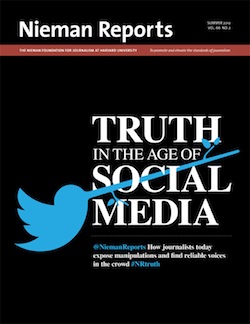

Editor’s Note: Our colleagues upstairs at Nieman Reports are out with their Summer 2012 issue, “Truth in the Age of Social Media,” which focuses on issues like verification, crowdsourcing, and citizen journalism. Over the past few days, we’ve been giving you a glimpse at some of their stories — but make sure to read the issue in full. In this piece, Craig Silverman explores the complexity of verifying content in real time, and across multiple platforms.
 In a handbook for aspiring journalists published in 1894, Edwin L. Shuman shared what he called one of the “most valuable secrets of the profession at its present stage of development.”
In a handbook for aspiring journalists published in 1894, Edwin L. Shuman shared what he called one of the “most valuable secrets of the profession at its present stage of development.”
He revealed that it was standard practice for reporters to invent a few details, provided the made-up facts were nonessential to the overall story. “Truth in essentials, imagination in nonessentials, is considered a legitimate rule of action in every office,” he wrote. “The paramount object is to make an interesting story.”
It was easy for a reporter of the time to get away with a few, or even a bushel of, inventions. Information was scarce and could take days or weeks to make its way to the public sphere. The telephone was not yet widely in use, and the first transatlantic wireless transmission was years away. The early mass-market Kodak Brownie camera was close to a decade from release. The machinery of publishing and distribution was in the hands of a few.
If a reporter wanted to fudge a few details to make his story a little more colorful, well, chances are no one would notice or call him on it. Shuman’s advice is objectionable, but something about it — and the information and reporting environment in which it was offered — seems quaint and charming by today’s standards.
It also highlights how much things have changed when it comes to accuracy and verification.
Image of fail whale by Brent Payne used under a Creative Commons license.